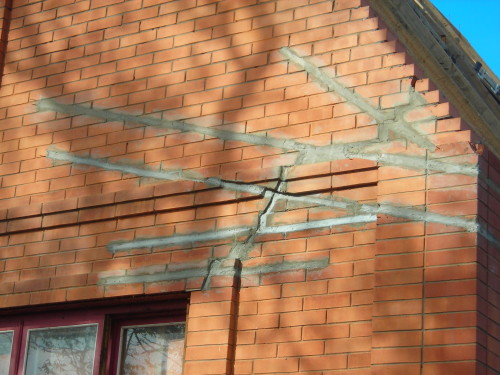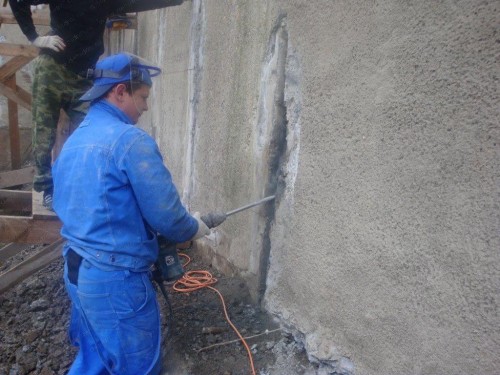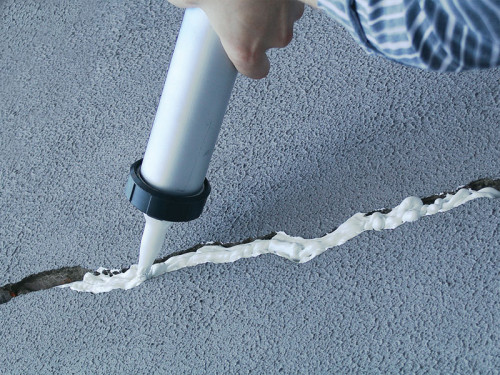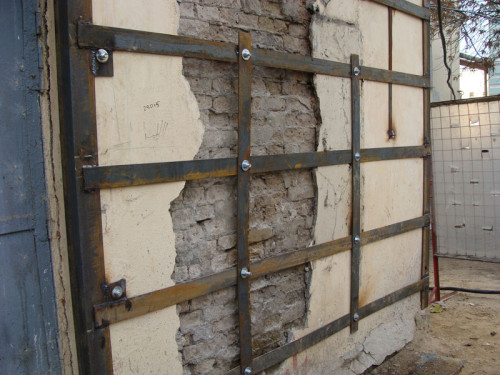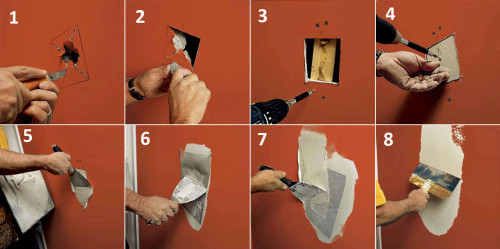A crack on the wall of a brick house is a serious problem. It must be eliminated anyway. Otherwise, over time, this is fraught with more devastating phenomena. Especially when it comes to a building from several floors.
Content
Causes of cracks in the wall
The occurrence of cracks in the walls can occur as a result of both natural phenomena (the presence of earthquakes, soil shrinkage, frosty, etc.) and errors during the construction of construction works (incorrect category of foundation, gasket of communications under the foundation already made).
Pretty frequent phenomenon - laying of communication systems after trenche coppes under the bottom of the building. As a result, there is a violation of the strength of the foundation, which actually saves on some plot. In the absence of the stock of the strength of such a "deflection" leads to the appearance of destructive forces inside the wall.
According to experts, the main "culprit" of the appearance of cracks are uneven deformation changes in the foundation of the house. Upon exceeding the limit value of the deformation coefficient, the walls cannot withstand excessive voltage. Although shrinkage can occur with a completely permissible phenomenon when there are no cracks at all.
There are also such basic causes of cracks on a brick wall:
- the presence of a large slope on the ground;
- low groundwater occurrence;
- insufficient foundation depth;
- incorrect bandage of bricks during masonry;
- lack of waterproofing materials and drainage systems (with a predominance in a rainy region);
- error choosing a type of foundation;
- the device basement after the completion of construction works;
- the absence of a sand pillow (or poorly compacted) under the foundation.
Cracks themselves may have different sizes. Their close should be carried out at the initial stage. Early elimination of this problem will relieve each of the maximum amount of financial and labor resources.
Also there are cracks and on various types of surface of the walls. We will talk about it in more detail.
Stucco (concrete) from cracks in the wall
Cracks in a concrete surface may appear both with outdoor and from the inside of the house. Causes of their appearance:
- violation of the proportion of components in the manufacture of means for sealing cracks;
- improper application of plaster or care for it;
- creation of too thick layer at a time (more than 3 cm).
The slots may occur in the absence of a reinforced material, the best of which is glass cholester. To mount this material, the base is ground, dries and covered with special glue. The glass cholester is placed on glue, after which it is closed with a finish putty.
Sealing cracks in concrete is carried out based on the type of damage. In the presence of strip microcracks:
- the old coating is removed;
- plaster is processed by a deep impregnation;
- after drying, a thick dispersion paint is applied on the gap.
A rather complicated process is the restoration of the plaster layer, which cracks due to the uneven shrinkage of the house. The cracks are closed without problems. But it does not eliminate their appearance in subsequent shrinkage processes.
The process itself consists of the following steps:
- the gap expands and moistened;
- a plaster mortar is rubbed into it;
- a ribbon -erpian is stacked over the solution (its edges should be over the extreme part of the crack);
- there is a sealing crack plaster.
When concrete walls decorated with plaster are repaired, the cement is recommended to add a special emulsion. Completely suitable composition for sealing cracks of the RSI, thanks to which:
- improve wear resistance and frost resistance of the surface;
- will increase resistance to moisture and chemicals;
- the likelihood of new cracks will decrease.
If it is necessary to eliminate the slots between different design elements (or when the seams diverged on adjacent walls made from different materials), then silicone sealant is used:
- the crack is cleaned from the old solution;
- with the help of a construction pistol, the sealant is extruded and stacked in the seam (for maximum depth);
- laid material smoothed out (finger hands or spatula);
Brick for sealing cracks in the wall
What to do if there are cracks on the wall of a brick house? First of all, the reason for this phenomenon should be established. Determine it easily:
- when expanding the crack at the bottom of the wall, there is an excessive load from the overlap;
- when expanding the slit at the top, the foundation is shy on this side of the house.
For high-quality sealing cracks, check the tendency to increase them. From different sides of the slots are pasted "Lighthouses" made of paper. After some time check them for integrity. If the crack does not increase, then you can proceed to repair work.
In order to qualitatively make cracks on the brick wall invisible, it is necessary to measure their width. This depends on the method of carrying out repair work.
Small cracks of size (up to 10 mm) are closed with a cement mortar, the laying of which is made after cleaning the slots from the old coating and watering water. You also need a hammer to remove some bricks from the extreme part of the cracks. In this way, the most optimal clutch of the solution with brick masonry is achieved.
If the width of the crack exceeds 10 mm, then this problem can be solved in one of three ways:
- Replacing bricks on a damaged area. Laying new bricks is carried out in the "Castle" with the addition of reinforcement or metal strips in the area of \u200b\u200bthe crack.
- Sealing cracks with sealant. After clearing and expanding the slit is filled with silicone sealant. The coating acquires the rubber form. This contributes to the fact that in the occurrence of deformation phenomena (narrowing or expansion), the sealant does not allow the appearance of cracks.
- Application of mounting foam. After filling the cracks, the frozen foam cuts into a depth of 20 mm. A concrete solution is stacked over the foam.
Strengthening brick masonry
To impart maximum strength and reliability, the wall should be enjoyed. Such a process, how to fix the crack on the brick wall, can be made both inside the house and outside.
For this, metal anchors are driven directly into the wall, and the so-called "lock" (metal profile) is superimposed on the crack in the transverse direction. For the attachment of anchors, dowels are used, which are located on both sides of the gap.
You can use steel brackets. Their ends should be placed in the wall to a depth of 50% of the wall thickness. Naturally, the holes are drilled in advance.
If the main reason for the occurrence of cracks on the wall lies in the violation of the Bookmark of the foundation, then an additional concrete belt is used to strengthen it. A trench is digging around the perimeter house. Its depth must exceed the depth of the base. At this depth and there is an additional fill of concrete.
Gypsum Carton from Cracked Wall
Causes of cracks in the drywall surface:
- violation of the requirements of fastening the frame of galvanized profiles;
- incorrect screwing of plasterboard sheets;
- incorrect putty of seams;
- sharp temperature differences;
- constant wet environments;
- the flooding of neighbors living on the top floor (in most cases they will have to not close the slots, but to completely change the walls).
Repair of the gaps in the plasterboard wall involves the following actions:
- there is a damaged area (the lines must be perfectly smooth);
- this area is cut with a hacksaw;
- a new piece of drywall is placed in the resulting opening;
- the plot is covered with glue to which fiberglass is mounted;
- while the glue dries, a putty is prepared for sealing cracks;
- the finishing putty is applied;
- the renovated surface is grouped by sandpaper.
Video of sealing cracks in the wall:


